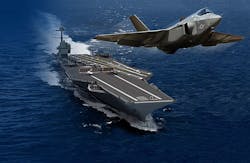High-power electronics at the heart of electromagnetic carrier launch and recovery systems
PATUXENT RIVER NAS, Md., 15 June 2015.High-power electronics experts at General Atomics will build next-generation all-electric aircraft launch and recover systems for the aircraft carrier USS John F. Kennedy (CVN 79), which is under construction in Newport News, Va.
Officials of the U.S. Naval Air Systems Command at Patuxent River Naval Air Station, Md., announced a $737 million contract modification Friday to the General Atomics Electromagnetic Systems Group in San Diego to build the Kennedy's Advanced Arresting Gear (AAG) and Electromagnetic Aircraft Launch System (EMALS).
Friday's contract brings the total value of General Atomics's AAG and EMALS work for the Kennedy to $763.6 million. The company won a $26.6 million long-lead-items contract in May 2014 for AAG and EMALS work on the Kennedy, which will be the second U.S. aircraft carrier of the Ford class.
The CVN 79 vessel will be the second carrier named for the 35th president of the United States. Construction began on the ship last year. It will be finished in 2018, and is expected to enter service in 2022. It may replace the carrier USS Nimitz (CVN 68).
The nuclear-powered Kennedy will be 1,106 feet long -- nearly four football fields long -- and will displace about 1,000 long tons. It will have two nuclear reactors and four huge propellers. The ship will be 134 feet wide, will be able to move faster than 30 knots and have a crew of 4,660. It will be able to accommodate as many as 90 Navy aircraft.
The General Atomics AAG and EMALS are two of the many design innovations that make the Ford-class carriers different from the U.S. Navy's Nimitz-class carriers that they will augment and eventually replace.
The Nimitz-class carriers have steam-powered catapults to launch aircraft, and heavy hydraulic aircraft arresting systems that help high-performance military aircraft land on their flight decks. Hydraulics are attached to the cables that aircraft tail hooks catch on landing to stop the aircraft.
Although steam-powered catapults and hydraulic arresting gear reliable, they represent technologies that are at last half a century old. Aircraft carrier steam catapults are large, heavy, inefficient, and difficult to control. Their biggest drawback is they not suitable for launching and recovering unmanned aerial vehicles (UAVs).
The General Atomics EMALS and AAG systems are different. Electromagnetic technology is far more efficient than steam catapults, and offer much finer control such that they can launch heavy manned aircraft, yet have fine enough control to launch light manned aircraft and UAVs.
Electromagnetic technology in the AAG system helps absorb the energy of landing aircraft with turboelectric engines, rather than hydraulics, which makes catching the arresting cable with the tail hook smoother with reduced shock on aircraft of all types.
On Friday's contract, General Atomics will do the work in San Diego; Tupelo, Miss.; Mankato, Minn.; Cincinnati; Waltham, Mass.; San Leandro, Calif.; New Milford, Conn.; Green Bay, Wis.; Cameron, Texas; and Aston, Pa., and should be finished by September 2022.
For more information contact General Atomics Electromagnetic Systems online at www.ga.com/ems, or Naval Air Systems Command at www.navair.navy.mil.

John Keller | Editor
John Keller is editor-in-chief of Military & Aerospace Electronics magazine, which provides extensive coverage and analysis of enabling electronic and optoelectronic technologies in military, space, and commercial aviation applications. A member of the Military & Aerospace Electronics staff since the magazine's founding in 1989, Mr. Keller took over as chief editor in 1995.

